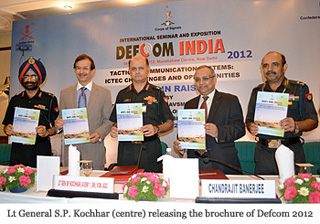INDIAN ARMED FORCES CHIEFS ON OUR RELENTLESS AND FOCUSED PUBLISHING EFFORTS

The insightful articles, inspiring narrations and analytical perspectives presented by the Editorial Team, establish an alluring connect with the reader. My compliments and best wishes to SP Guide Publications.

"Over the past 60 years, the growth of SP Guide Publications has mirrored the rising stature of Indian Navy. Its well-researched and informative magazines on Defence and Aerospace sector have served to shape an educated opinion of our military personnel, policy makers and the public alike. I wish SP's Publication team continued success, fair winds and following seas in all future endeavour!"

Since, its inception in 1964, SP Guide Publications has consistently demonstrated commitment to high-quality journalism in the aerospace and defence sectors, earning a well-deserved reputation as Asia's largest media house in this domain. I wish SP Guide Publications continued success in its pursuit of excellence.
- Appointments Committee of Cabinet approves one-month extension in service of Chief of the Army Staff
- Admiral Dinesh K. Tripathi assumes Command of the Indian Navy as 26th Chief of the Naval Staff
- Prime Minister witnesses 'Bharat Shakti' – a Tri-Services Firing and Manoeuvre Exercise in Pokhran, Rajasthan
- Interim Defence Budget 2024-25 — An Analysis
- Union Defence budget 2024
- Prime Minister Modi Commemorates Indian Navy Day in a Grand Ceremony
Tactical Communication Systems ICTEC challenges and opportunities
“My vision of a military network is one in which the users are transparent to the complexities of network engineering and are a part of one universal space.”
— Lt General S.P. Kochhar, SO-in-C, Signals

Technology has caused revolutionary changes in the field of defence communications, surveillance and weaponhandling capabilities. In modern and future battlefields, demand for real time/near real time situational awareness for decision-making has also increased considerably, which implies that the requirement of voice, video and data has become very large. In such a scenario, the successful integration of sensors, shooters and the decision-makers is achieved by networking numerous communications, electronic warfare and cyber elements using multiple media for various levels of operations and geographical boundaries. Military communications therefore translate information superiority into combat power and are a catalyst for operational success which is being achieved by networking the information communication technology (ICT) elements using multiple mediums including:
- Optical fibre cable and high capacity point-to-point wireless systems in the strategic sphere.
- High capacity point-to-point and point-to-multi-point wireless systems, mobile ad hoc wireless systems (based on numerous technologies like WiMax, Tetra, GSM and CDMA) and meshed combat net radio (based on IP and software defined radio) in the operational and tactical spheres.
- The access is achieved by using high capacity wideband wireless access systems, optical fibre cable and field cables in both.
- An overlay of satellite provides ‘beyond line of sight redundancy’.
Tactical Communication System
The need for a state-of-the-art tactical communication system (TCS) has been long felt and Project TCS was conceived to bridge the gap between the existing and contemporary technologies in this sphere. TCS will be the foundation of the Indian Army’s communication network which will be a robust, snoop-proof, mobile, cellular network for voice and data communications during battle. It will allow integrated communication at multiple levels and include a broad range of subsystems from cellular telephones to equipment sensors. With the selection of two development agencies, Bharat Electronics Limited (BEL) and a consortium of Larsen and Tubro (L&T), Tata Power SED and HCL Infosys Ltd, TCS, has become the first mega project to reach the design and development stage of the ‘Make’ procedure under the Defence Procurement Procedure 2011. The Indian industry is being given an opportunity to participate in the project and exhibit its prowess.
A network-centric force will have the ability to share and exchange information in near real time between various geographically distributed operational elements like: sensors, regardless of platform; shooters, regardless of service affiliations; and decisionmakers and supporting organisations, regardless of location.
The management of such a large array of systems has many challenges. Spectrum management becomes complex as it is crowded with an increase in the applications which require larger bandwidths. Thus modern communication systems exploit information communication technology, electronics and cyber (ICTEC), as complex and complementary sub-systems of military communication networks. Therefore, as a part of the Army’s transformation process, replacing civil-oriented ICT philosophy (primarily a systems framework) to a military-oriented ICTEC philosophy (a networks structure) is inescapable and will contribute immensely in developing and fielding the TCS.
Keeping the vision of transforming the Indian Army into a netcentric force, Corps of Signals, the communication arm of the army alongwith the Confederation of Indian Industry (CII) jointly is organising DEFCOM, an annual seminar-cum-exposition. This year DEFCOM 2012 will be organised on November 8-9 at the Manekshaw Centre, New Delhi for which the curtain-raiser event was organised on July 27, 2012, where the brochure of the seminar was released. The theme for this annual event has been aptly chosen as “Tactical Communication Systems: ICTEC Challenges and Opportunities”. The objective of the seminar is to enable defence officers, academia and the industry to understand user requirements and propose befitting solutions for the tactical battle area (TBA). The seminar will be carried out in three technical and two workshop sessions. The session on “Robust Networks for Tactical Communications” will focus on the ability of tactical networks to adapt to rapidly changing conditions. The session on “Supporting Net-centric Operations through Wireless Technologies” will compare constraints in the current commercial 3G and 4G wireless networks with software defined radio-based wireless networks capable of self-organising themselves for broadband wireless access in the TBA. The session on “Mitigating Security Threats in Tactical Networks” will discuss measures to make tactical networks secure and robust. The session on “Human Capital Transformation in ICTEC Era” will focus on challenges and opportunities in this field. It will also recognise the strengths of military veterans who are a valuable, disciplined and trained force available to the industry.





